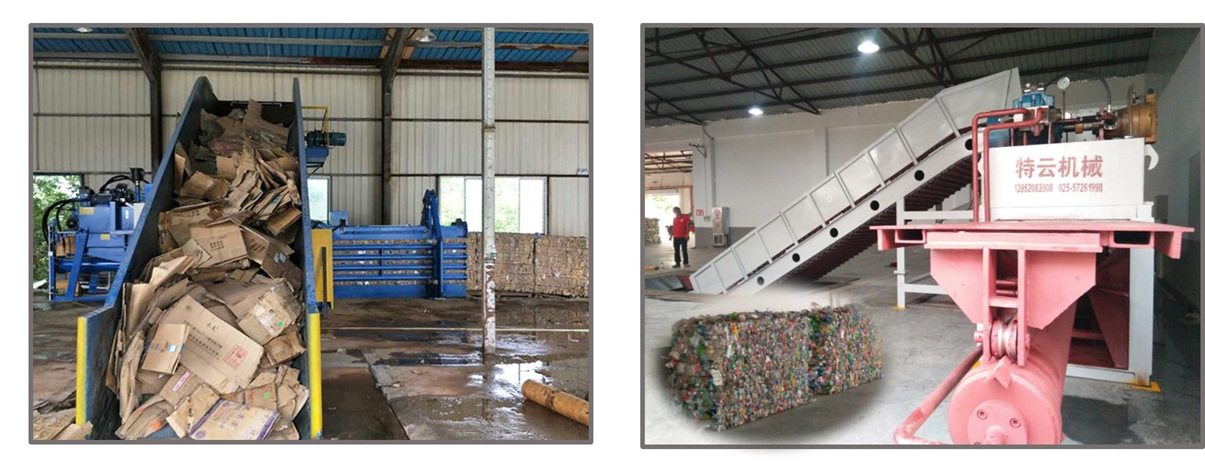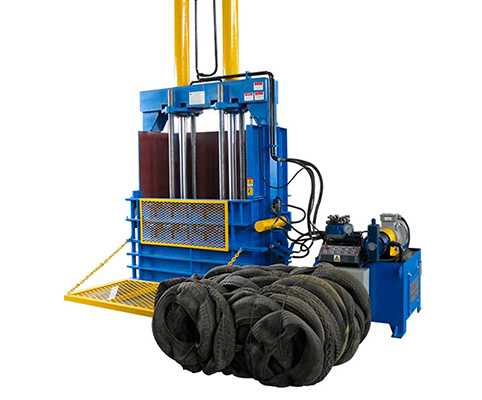Horizontal Balers
Horizontal balers process waste differently than vertical balers. Recyclable waste goes into a hopper, and once the hopper is full, a piston on the side compresses the material with a horizontal force until the bale is complete. The bale is then tied with wire and ejected.

Advantages of Horizontal Balers
1.More Applications: Most horizontal balers can process a variety of materials, such as painted aluminum siding or radiators. They can produce bales of non-elastic materials such as newsprint and paper.
2.Higher Production: Horizontal balers can process more volume and larger bales per day than vertical models.
3.Consistency: The bales they produce are of consistent density and weight, making them easier to store.
4.Convenience: Horizontal balers can be used with underground or above-ground conveyors, shredders, and air systems.
Disadvantages of Horizontal Balers
1.Size: Horizontal balers require more floor space than vertical balers. For example, some models are even up to 40 feet long, including platforms and stairs.
2.Price: Horizontal balers are generally more expensive than vertical balers. If purchased with a conveyor or shredding system, the cost can be even higher.
Vertical Balers

Advantages of Vertical Balers
1.Smaller Footprint: Vertical balers take up much less space than horizontal balers, so they can be used in a variety of applications.
2.Cost: Vertical balers typically cost much less than horizontal balers, about one-fifth or even one-tenth the price of horizontal balers.
3.Variety of Materials Handled: Vertical balers can be used to handle almost all types of recyclable waste - from simple office paper to non-ferrous metals. Some vertical balers are also specialized, and they can handle aluminum, plastic beverage containers, or storage drums.
Disadvantages of Vertical Balers
1.End Product: Smaller models may produce bales that do not meet "factory standards", which makes it more difficult to find end users willing to purchase them.
2.Height: Their height can also be an issue for some applications—vertical balers can be much taller than their horizontal counterparts.
3.Paper: Vertical balers may not be suitable for recyclables that are less flexible when baled—such as office paper or newsprint.
Which baler is right for me?
When comparing your options for purchasing a baler, ask these questions:
How many bales will I produce per day?
Typically, vertical balers are best suited for operations that produce no more than eight to ten bales per day. For operations with higher production volumes, consider a horizontal baler.
How much space do I have?
Consider the operating height and available floor space. Remember that you'll also need room for maintenance.
What's your budget?
When choosing a baler, consider the investment costs associated with the type you purchase. Also, don't forget to include the cost you can get for selling the baled material.
If you are interested in our vertical and horizontal balers, please contact us.


 Address : Mingjue Industry Park, Lishui District, Nanjing City, Jiangsu Province
Address : Mingjue Industry Park, Lishui District, Nanjing City, Jiangsu Province

 français
français русский
русский español
español العربية
العربية 日本語
日本語 Tiếng Việt
Tiếng Việt 中文
中文








 IPv6 network supported
IPv6 network supported